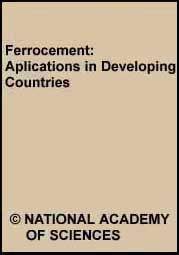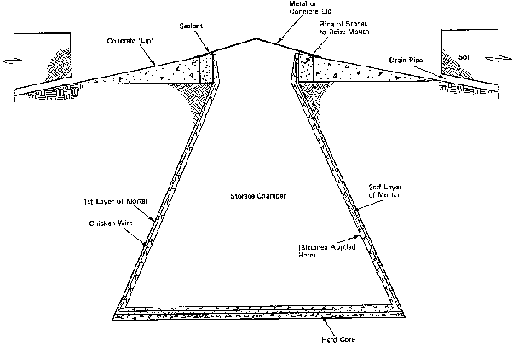
Ferrocement Applications in Developing Countries (BOSTID, 1973, 89 p.)
Appendix C
Ferrocement-Lined Underground Grain Silos in Ethiopia
In Harar Province, Ethiopia, underground pits are the traditional method of grain storage. It is estimated that 62 percent of the farmers use pit storage exclusively and a further 8 percent use pits in combination with other storage methods.** The basic shape of pit stores resembles that of a laboratory conical flask. The mouth of the pit is closed by strips of wood sealed with a mixture of mud and dung. The pits, if fairly well sealed and covered with a good depth of hard-packed soil, should provide a reasonably airtight storage chamber. In such a chamber any insects present in the stored grain should be killed as the oxygen is used up. However, unless the pit and grain are both dry, some mold growth is inevitable. In practice, few traditional pits are sufficiently airtight to eliminate insects, and mold damage is often considerable.
When the traditional pit is lined with ferrocement and provided with an improved airtight lid, a truly hermetic and waterproof storage chamber can be achieved.
Traditional pits in Harar Province hold from ½ to 20 tons of grain, but there are records of pits holding 50 to 70 tons. In theory, even the largest could be ferrocement lined, but to date the largest lined pit has a 7-ton capacity. This pit was approximately 3 meters deep and 4 meters at maximum width. Most lined pits hold ½-2 tons. A ½-ton pit is approximately 1 meter deep by 1 meter at the widest point; a 2-ton pit is correspondingly 1.75 meters by 2 meters.
Pit stores are built in all the major soil types of the province. Ferrocement linings have been shown to be satisfactory in even the wettest soil.
The ferrocement lining can be produced by any local laborers who are familiar with the use of cement in house building, but even local unskilled laborers can soon learn to do the work satisfactorily. After a 2-3 hour training period, unskilled laborers were able, without close supervision, to help other untrained workers with the techniques.
Although the materials needed are relatively cheap, they are sometimes beyond the reach of the small farmer. For these cases some assistance is likely to be forthcoming when the farmers' cooperatives, now in the early stages of development, become established. A factory in Dire Dawa, one of the two largest towns in the province, makes a standard grade of cement which is distributed throughout the province to even the smallest villages on a main highway or all-weather road. Wire mesh, in various grades, is available in all the major towns and in most villages served by an all-weather road. In most areas sand is available from dry riverbeds, but in some parts of the province graded and washed sand can be obtained.
Extension agents of the Imperial Ethiopian Government, Ministry of Agriculture, have been closely involved with the development of the improved pits and have received training in the use of ferrocement linings. Through this agency the general ideas of pit improvement are being disseminated to the local farming communities.
TABLE C-1. Costs on 1-Ton Ferrocement-Lined Storage Pit, 1972 (in US 0 (a)
|
Using a bitumen lining as waterproofing barrier | |
|
Labor (skilled) |
.50 |
|
Labor (unskilled farmer assisting skilled laborer) |
nil |
|
Materials | |
|
Cement |
5.20 |
|
Sand |
nil |
|
Aggregate |
nil |
|
Bitumen |
1.00 |
|
Chicken wire |
2.20 |
|
Miscellaneous-transport, hiring tools, etc |
2.10 |
|
Using bitumen emulsion ("Flintkote") |
.00 |
|
Extra cost .50, therefore total |
.50 |
(a) Based on average for all of Harar Province, Ethiopia. In remote areas, the price of materials is likely to be higher; in areas close to large towns, considerably lower.
TECHNICAL DETAILS OF FERROCEMENT PIT CONSTRUCTION (See Figures C-1- C-3.)
Before a pit is lined, a thorough cleaning operation is carried out: all rubbish is removed, and, when necessary, the walls are smoothed by scraping off loose soil. Evidence of termites is sought, and if found, the walls of the pit may be treated with an appropriate termiticide. A layer of hardcore is laid on the floor of the pit to a depth of about 10 cm, and a layer of concrete is laid on top. A layer of mortar 2.5-3 cm is applied by hand and trowel to the walls. The mortar consists of 1 part cement to 3 parts sand with as little water as possible. A chicken-wire mesh reinforcement is tacked onto the surface while it is still moist, and a second layer of mortar is applied on top. The lining is moist-cured for 5 to 7 days, after which a waterproofing coat is applied. The surface is prepared by brushing off loose material with a wire brush, and a priming coat of bitumen emulsion is diluted 1 volume of emulsion to 1 volume of water and applied with a stiff brush. The emulsion is scrubbed well into the cement layer. After the priming coat is dry, a bonding coat of neat emulsion is applied and allowed to dry. Finally, a cement/ emulsion mixture, using 1 volume of water to 1 volume cement to 10 volumes of emulsion is prepared and brushed over the whole surface of the lining.
Because this waterproofing method using bitumen emulsion is a relatively expensive and sophisticated treatment, a single layer of bitumen has been tested. This layer, applied between the two cement layers, has been found to be perfectly satisfactory. However, bitumen is available only in large drums and is rather difficult to apply to the sloping walls of a pit. No really easy way of applying it has yet been found.
The design of the mouth of the pit has been modified to incorporate a sloping lip, which will carry away any water that might penetrate the soil. Drain pipes can easily be included to carry the water even farther from the pit (Figure C-3).
The traditional wood-strip lid can be used with the lined pit; however, when a metal or concrete lid is used with a sealant such as bitumen, a truly airtight store can be obtained. Condensation on the inner surface of metal lids sometimes occurs, but can be avoided by use of a piece of old sacking as an inner liner.
Figure C-3. Cross-section of ferrocement underground storage pit
